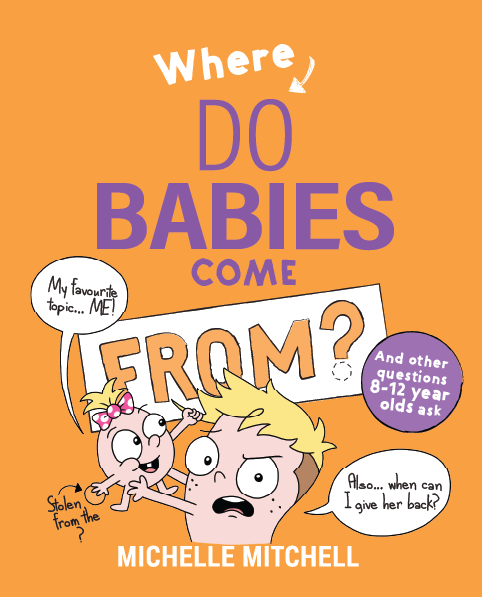ABOUT THIS BOOK
Where Do Babies Come From and other questions 8 – 12 year olds ask is a treasure trove of accessible information and unforgettable comics. Endorsed by leading medical, parenting, and education professionals, this book empowers tweens with accurate, age-appropriate answers in a world overflowing with misinformation. It’s the resource every curious mind—and their parents—will appreciate.
You can expect
- The latest science. You can count this book to give you medically accurate information tailored for a tween audience.
- Consideration of developmental needs. Tweens are curious learners who think concretely. This book breaks down complex topics, anchors them in values, and prioritizes your child’s safety every step of the way.
- Memorable moments. Packed with comics and humour, this book will engage even the most reluctant readers. It’s designed to spark meaningful conversations you’ll treasure forever. You can thank me later, parents!
What’s in This Book?
Section 1: Let’s Get Started
This section is all about communication preferences. It introduces them as the boss of the book. They get to map their course, allowing them to choose how they want to read the book and communicate with trusted adults. It also discusses feeling misunderstood, how to ask trusted adult’s questions, different family’s talking styles and what to do if they hear something that doesn’t sound quite right.
Section 2: The Basics
Here is where they get to meet the superstar characters – Zen Den, Ellie the Egg and Swiftie the Sperm. The Story really begins when Sir Halt asks for 5 short minutes to explain how the egg and sperm meet, and they hear about the instruction manual that made them the unique person that they are. We also talk multiple babies, and how they are formed and bust some myths with some very fun comics.
You will see below the format Michelle has chosen to visually represent sexual intercourse.
Section 3: Other Ways Babies Are Made
This section is all about assisted reproductive technology, which is not only fascinating but come in very handy when it comes to helping families have babies. Things like IVF and ovulation stimulation, spermbots, egg and sperm donation, surrogacy, as well as egg, sperm, and embryo freezing are all part of ART. We discuss these, along with some quizzical questions that kids ask.
Section 4: You and Your Family
Not all kids live with their biological parents, so this chapter is all about reinforcing the importance of family. We talk about family being the people who who take care of you and live with us and use their superpowers to look after us every day. Kids also have extended family. These are the people who are a regular part of their lives but may not live with them. I personally think they are significantly underrated so they get a mention! We talk about adopted families, and foster families and tweens get to answer 50 questions about them.
Section 5: There is More to Know
This section gives kids the practical stuff about sex that they need to know. We talk about male and female orgasms, contraception, sexually transmitted infections, staying safe online and sexual consent. It’s a shorter but deeper content section that tweens can head to when they feel they are ready to explore these topics.
Section 6: Crazy, Cool Facts
Many kids love hearing about babies, and all the cute, interesting details about how they grow in the womb. This section is beautifully illustrated, very funny, and full of medical facts and comics that help tweens explore the journey babies are on as they grow. We explore three trimesters and then a range of quizzical questions that might arise.
Section 7: How Babies Enter the World
This section starts with some five star entertainment to bust some myths about how babies entre the world. We talk about birth plans, vaginal births, caesarean births and how babies tend to have a mind of their own!
Section 8: Important Stuff
This section is a recap of reproductive body parts, so kids have a reference point for any of the body parts I mention in the book. I also cover the menstrual cycle and link that to sex and how babies are born in more detail. There is a quizzical questions section where we cover the difference between biological bodies and the gender someone might choose as they grow, and they will find a short vocabulary guide.
Some Pages You Might Like To View
To help you get a feel for the tone of the book, I have chosen a few pages for you to view.
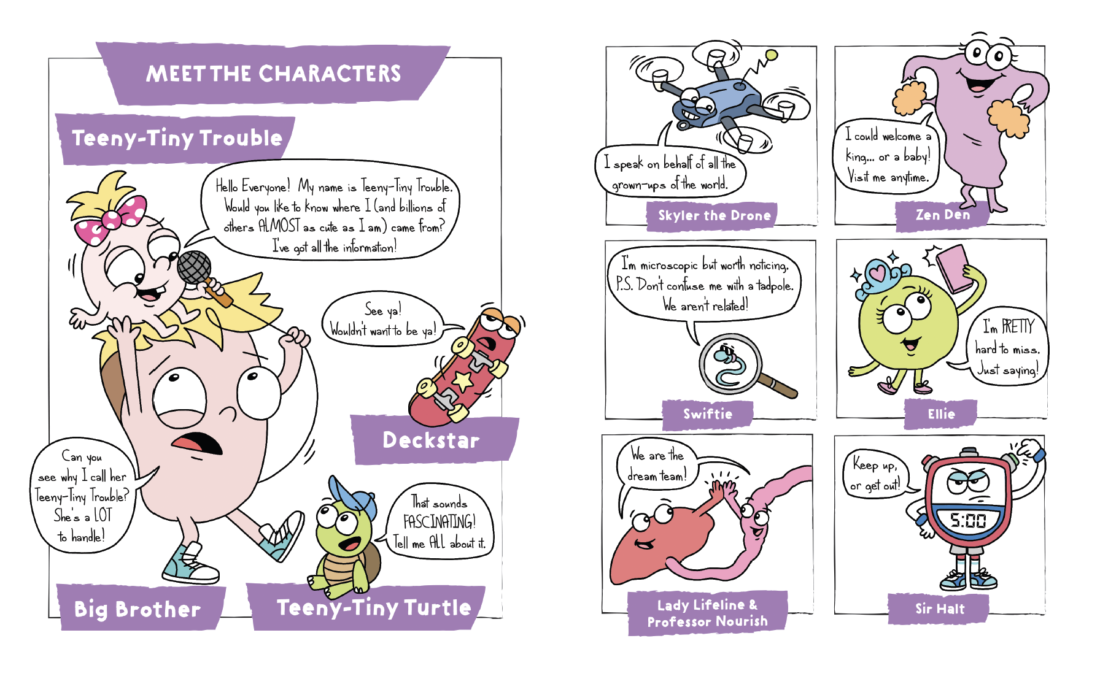
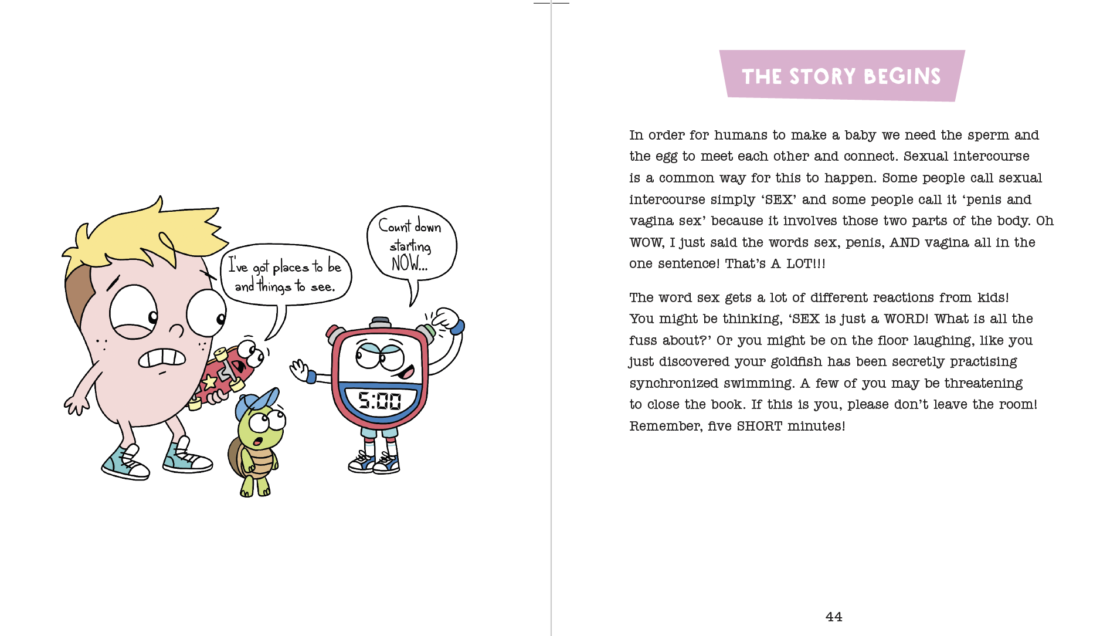
Page 46 and 47. And here’s a little more! You might notice Sir Halt in the corner. He’s given us 5 short minutes to get through the more awkward content.

Page 57 – 60. Every parents wants to know how this book explains sexual intercourse! I have deliberately chosen to use diagrams instead of sketches of people. Hopefully this will be a soft introduction, and an easy way to open conversation. There are a lot of children’s picture books you can access that you can add to this if you’d like to.
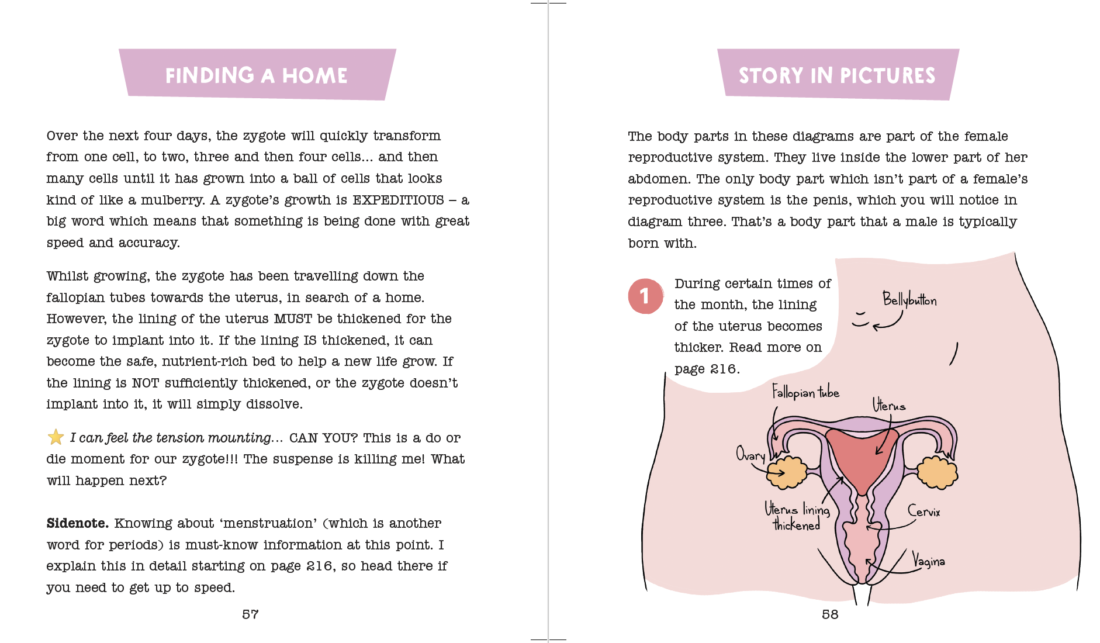
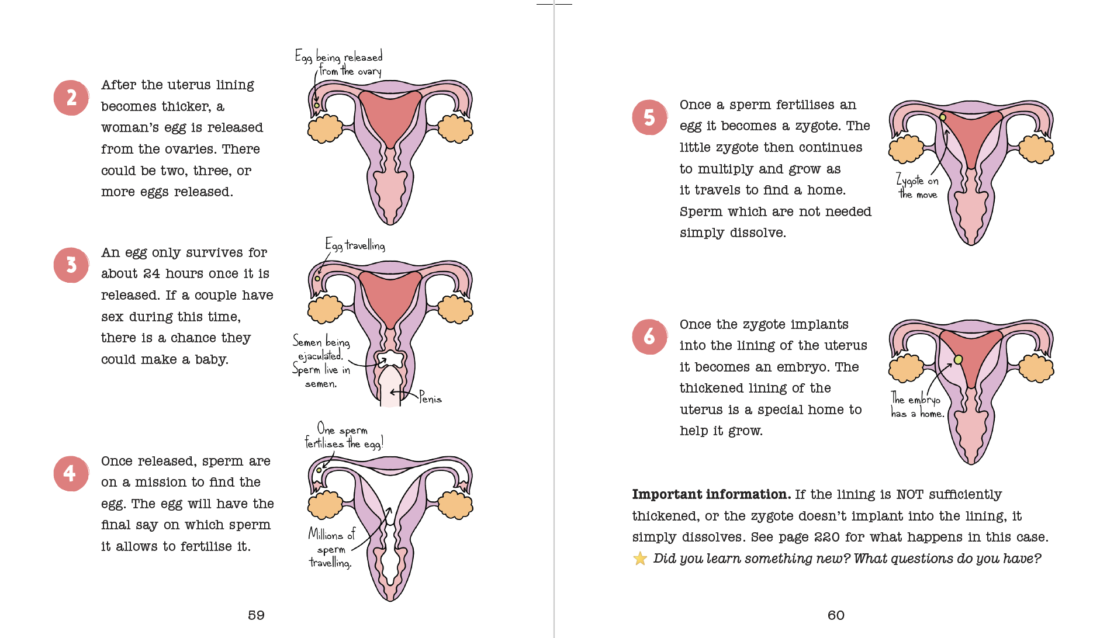
Page 82. This section is all about assisted reproductive therapies (ART for short). ART refers to medical procedures that help families have babies. Things like IVF and ovulation stimulation, spermbots, egg and sperm donation, surrogacy, as well as egg, sperm, and embryo freezing are all part of ART.

Page 80. And there is endless fun… as well as a deep dive into information about babies that I know tweens are completely fascinated with.
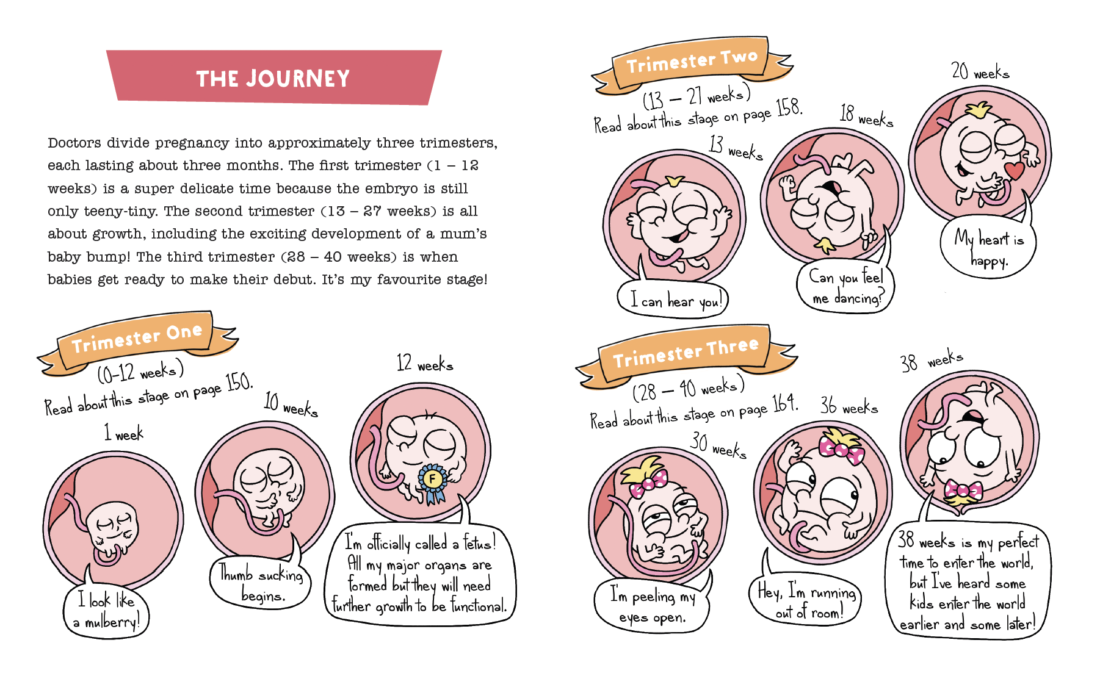
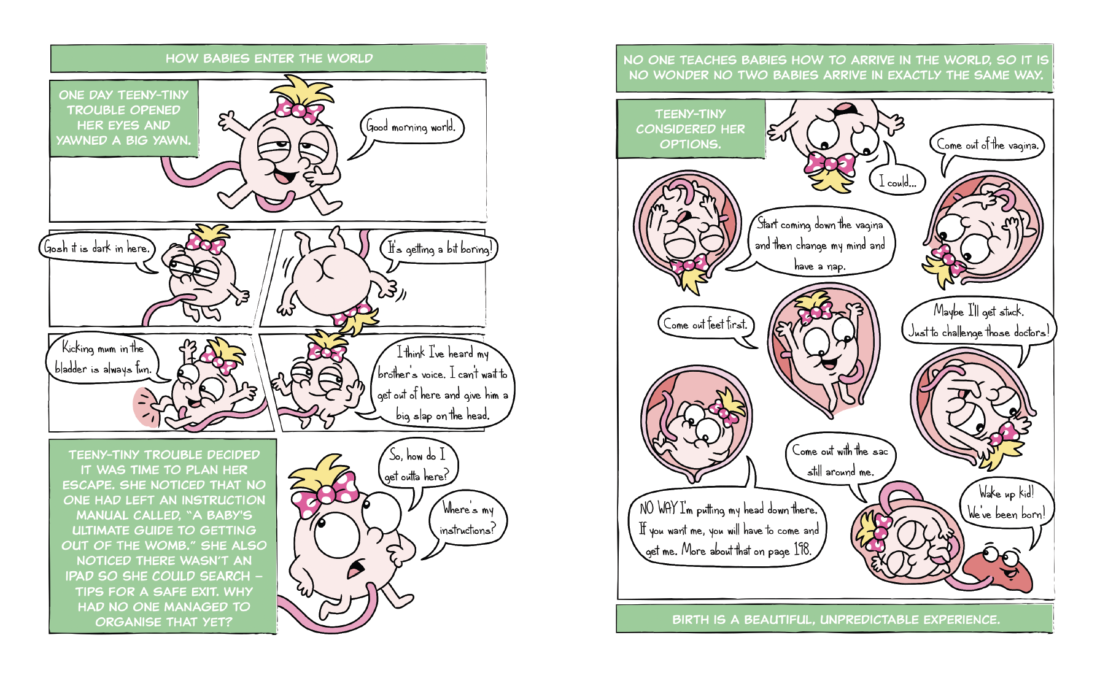

Page 135. We do have a few pages dedicated to staying safe online after we talk about body safety and sexual consent.
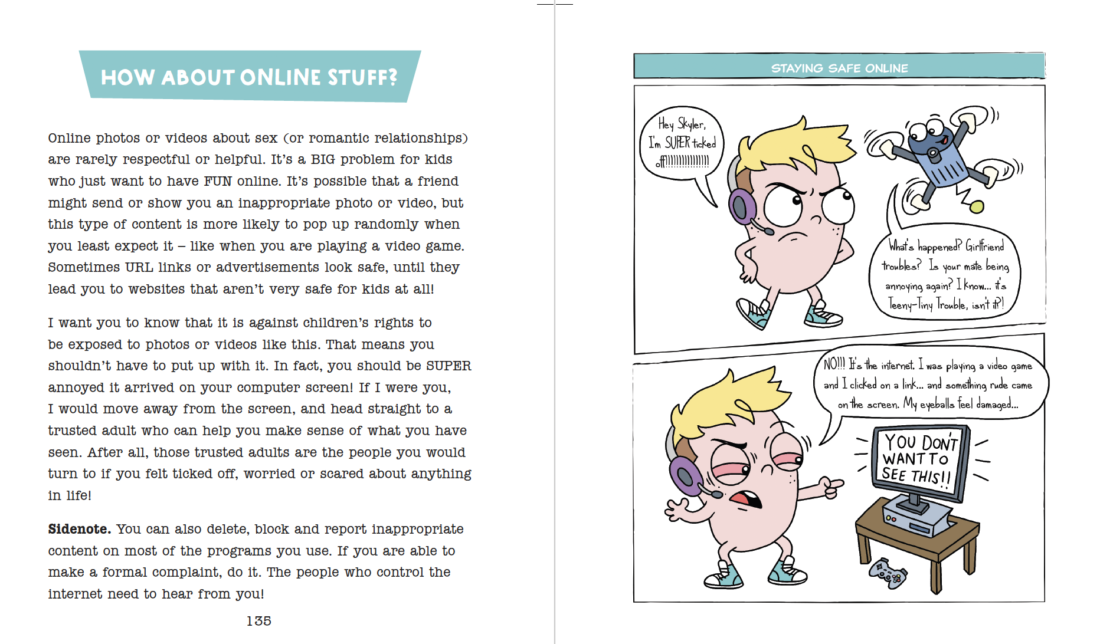
Common Questions Answered.
Any sexual health books you give your kids needs to be an extension of you, not a replacement of you. Consider this book a comprehensive, solid start point that you will layer further information on as your child grows.
Is this book suitable for a neurodivergent tween?
Absolutely yes. This book is very inclusive and includes the step by step clarity that many neuro types need. The visual elements of this book also help to keep kids’ attention. We are very lucky to have many stockists who specialise in inclusive education and neurodiversity who recommend Michelle’s tweens books. See below for some….
How do you talk about sexual intercourse?
This book doesn’t use illustrations of adults having sex but instead uses diagrams of the anatomy to show how the egg and sperm meet. This book hopes to provide an easy, comfortable visual for parents and kids to discuss the topic.
How do you talk about sex and gender?
This book refers uses the words male and female and refer to the biological sex a person is born with. It also explains the difference between biological sex and gender.
Does this book talk about dating and romance?
This book is not a deep dive into sexual feelings, romance or dating. That’s a whole other conversation. We touch very briefly on sexual consent.
Does this book talk about puberty?
We briefly recap on reproductive body parts and menstruation to enable the content in this book to be understood. However, content on puberty can be found in Michelle’s A Guy’s Guide to Puberty or A Girls’ Guide to Puberty.
If you have further questions you can always reach us at shop@michellemitchell.org. We are here to help!
Praise For This Book
Michelle Mitchell has created another outstanding book for young people and their families. In a world where credible information about bodies, babies, and sexual activity can be hard to find, Where Do Babies Come From? is an invaluable resource. This book provides vital knowledge to young people in an engaging, age-appropriate way and supports parents to have meaningful and important conversations with their children.
Dr Jacqui Hendriks – Sexuality Educator and Academic
PhD PGradDipSexol PGradDipHltProm BSc
This book needs to be in every home! Kids are naturally curious and this delightful book written by the wise, wonderful Michelle Mitchell brings all the awkward facts about sex in a light, easy to read manner. The quirky, funny illustrations make the information so easy to understand and remember.
Maggie Dent – Parenting Educator and Resilience Specialist
Michelle Mitchell has crafted a remarkable book that encourages children to explore this essential topic at their own pace. For our wonderful children with ADHD, this book’s style honours their agency and empowers them with the necessary information, using real terms in a simple, engaging, and fun way. It makes the learning experience both enjoyable and impactful. Her work is a gift to both parents and young readers alike.
Sharon Collon – Certified ADHD Coach and founder of The Functional Family
I would love to see “Where Do Babies Come From” on every bookshelf in every family home.
We parents need to get in first to arm our kids with accurate, safe and age-appropriate information instead of them learning harmful rubbish on the internet or from someone’s big brother in the playground.
Kasey Edwards is a columnist and international best selling author. (Her latest book is Raising Girls Who Like Themselves.)
